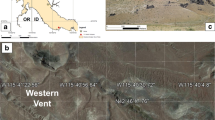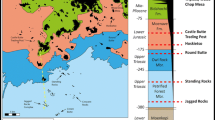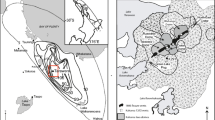Abstract
The 14 ka Puketarata eruption of Maroa caldera in Taupo Volcanic Zone was a dome-related event in which the bulk of the 0.25 km3 of eruption products were emplaced as phreatomagmatic fall and surge deposits. A rhyolitic dike encountered shallow groundwater during emplacement along a NE-trending normal fault, leading to shallow-seated explosions characterised by low to moderate water/magma ratios. The eruption products consist of two lava domes, a proximal tuff ring, three phreatic collapse craters, and a widespread fall deposit. The pyroclastic deposits contain dominantly dense juvenile clasts and few foreign lithics, and relate to very shallow-level disruption of the growing dome and its feeder dike with relatively little involvement of country rock. The distal fall deposit, representing 88% of the eruption products is, despite its uniform appearance and apparently subplinian dispersal, a composite feature equivalent to numerous discrete proximal phreatomagmatic lapilli fall layers, each deposited from a short-lived eruption column. The Puketarata products are subdivided into four units related to successive phases of:(A) shallow lava intrusion and initial dome growth; (B) rapid growth and destruction of dome lobes; (C) slower, sustained dome growth and restriction of explosive disruption to the dome margins; and (D) post-dome withdrawal of magma and crater-collapse. Phase D was phreatic, phases A and C had moderate water: magma ratios, and phase B a low water: magma ratio. Dome extrusion was most rapid during phase B, but so was destruction, and hence dome growth was largely accomplished during phase C. The Puketarata eruption illustrates how vent geometry and the presence of groundwater may control the style of silicic volcanism. Early activity was dominated by these external influences and sustained dome growth only followed after effective exclusion of external water from newly emplaced magma.
Similar content being viewed by others
References
Blake S (1990) Viscoplastic models of lava domes. In: Fink JH (ed) Lava flows and domes. Springer, New York, 88–126
Brooker MR (1988) The geology of the puketarata tuff ring and domes, Maroa Volcanic Centre. Unpublished BSc (Hons) thesis, Victoria University, Wellington, New Zealand
Eichelberger JC, Carrigan CR, Westrich HR, Price RH (1986) Non-explosive silicic volcanism. Nature 323:598–602
Forggatt PC, Lowe DJ (1990) A review of late Quaternary silicic and some other tephra formations from New Zealand: their stratigraphy, nomenclature, distribution, volume and age. NZ J Geol Geophys 33:89–109
Heiken GH (1978) Plinian-type eruptions in the Medicine Lake Highland, California and nature of the underlying magma. J Volcanol Geotherm Res 4:375–402
Heiken GH, Eichelberger J (1980) Eruptions at Chaos Crags, Lassen National Park, California. J Volcanol Geotherm Res 7:443–481
Heiken GH, Wohletz KH (1987) Tephra deposits associated with silicic domes and lava flows. Geol Soc Am Spec Pap 212:55–76
Houghton BF, Wilson CJN (1989) A vesicularity index for pyroclastic deposits. Bull Volcanol 51:451–462
Lloyd EF (1972) Geology and hot springs of Orakeikorako. NZ Geol Surv Bull 85
Newhall CG, Melson WG (1983) Explosive activity associated with the growth of volcanic domes. J Volcanol Geotherm Res 17:111–131
Pyle DM (1989) The thickness volume and grainsize of tephra fall deposits. Bull Volcanol 51:1–15
Sheridan MF, Marshall JR (1983) Interpretation of pyroclastic surface features using SEM images. J Volcanol Geotherm Res 16:153–159
Sieh K, Bursik M (1986) Most recent eruptions of the Mono Craters, eastern central California. J Geophys Res 91:12539–12571
Swanson DA, Dzurisin D, Holcomb RT, Iwatsubo EY, Chadwick WW, Casadevall TJ, Ewert JW, Heliker CC (1987) Growth of the lava dome at Mount St Helens, Washington (USA), 1981–1983. Geol Soc Am Spec Pap 212:1–17
Walker GPL (1980) The Taupo Pumice: product of the most powerful known (ultraplinian) eruption? J Volcanol Geotherm Res 8:69–94
Walker GPL (1983) Ignimbrite types and ignimbrite problems. J Volcanol Geotherm Res 17:65–88
Wohletz KH (1983) Mechanisms of hydrovolcanic pyroclast formation: grain-size, scanning electron microscopy, and experimental studies. J. Volcanol Geotherm Res 17:31–63
Author information
Authors and Affiliations
Rights and permissions
About this article
Cite this article
Brooker, M.R., Houghton, B.F., Wilson, C.J.N. et al. Pyroclastic phases of a rhyolitic dome-building eruption: Puketarata tuff ring, Taupo Volcanic Zone, New Zealand. Bull Volcanol 55, 395–406 (1993). https://doi.org/10.1007/BF00301999
Received:
Accepted:
Issue Date:
DOI: https://doi.org/10.1007/BF00301999




